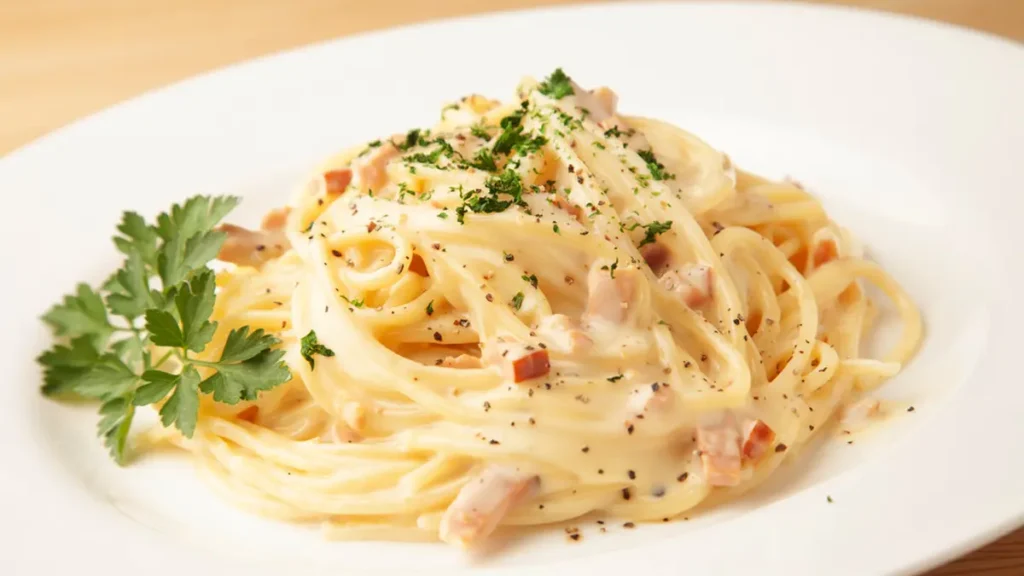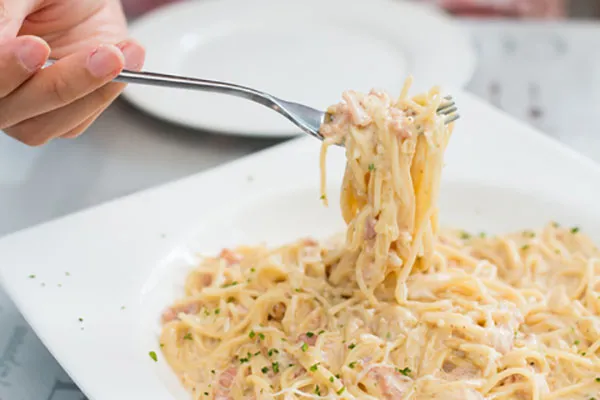Spaghetti Carbonara is one of the most beloved and classic dishes in Italian cuisine. Known for its creamy, savory sauce and rich flavors, it has a storied history and a reputation that has made it a favorite worldwide. This article explores the origins, traditional ingredients, and preparation methods of Spaghetti Carbonara, along with its variations and cultural significance.
Historical Background Spaghetti Carbonara

The exact origins of Spaghetti Carbonara are somewhat shrouded in mystery, with several theories about how the dish came to be. One popular belief is that Carbonara was created by Italian coal miners. The name “carbonara” is derived from “carbone,” which means coal in Italian. According to this theory, the dish was popular among coal miners who needed a hearty, simple meal that could be easily prepared with available ingredients.
Another theory suggests that Spaghetti Carbonara emerged during World War II, when American soldiers stationed in Italy shared their rations of bacon and eggs with local Italians. These ingredients were then combined with pasta to create the dish we know today.
Despite the uncertainty surrounding its origins, what is clear is that Carbonara is a relatively modern addition to the Italian culinary repertoire, likely becoming popular in the mid-20th century. It quickly gained fame for its delicious simplicity and has since become a staple of Italian cuisine.
Traditional Ingredients
The beauty of Spaghetti Carbonara lies in its simplicity. The traditional recipe calls for just a few high-quality ingredients:
- Spaghetti: The classic pasta choice for Carbonara, though other pasta shapes like rigatoni or fettuccine can also be used.
- Guanciale: This is cured pork jowl or cheek, which has a rich, fatty flavor. In some variations, pancetta (Italian bacon) or regular bacon may be used as substitutes, but purists insist on guanciale for its authentic taste.
- Eggs: Fresh eggs are essential for creating the creamy sauce. Typically, a combination of whole eggs and egg yolks is used.
- Pecorino Romano: A sharp, salty sheep’s milk cheese that is grated and mixed into the sauce. Parmesan cheese can be used in some versions, but Pecorino Romano is traditional.
- Black Pepper: Freshly ground black pepper adds a spicy kick and complements the richness of the dish.
Preparation Method
Preparing Spaghetti Carbonara requires attention to detail and a few specific techniques to achieve the perfect balance of flavors and textures. Here is a step-by-step guide to making traditional Spaghetti Carbonara:

- Cook the Spaghetti: Bring a large pot of salted water to a boil and cook the spaghetti until it is al dente, according to the package instructions. Reserve about a cup of the pasta cooking water, then drain the pasta.
- Prepare the Guanciale: While the pasta is cooking, cut the guanciale into small, bite-sized pieces. In a large skillet, cook the guanciale over medium heat until it is crispy and the fat has rendered. Remove the skillet from the heat and set it aside.
- Make the Egg Mixture: In a mixing bowl, whisk together the eggs, egg yolks, and grated Pecorino Romano cheese until well combined. Season generously with freshly ground black pepper.
- Combine the Ingredients: Once the pasta is cooked and drained, quickly add it to the skillet with the guanciale. Toss to coat the pasta in the rendered fat. Then, immediately pour the egg and cheese mixture over the hot pasta, tossing continuously to create a creamy sauce. The heat from the pasta will gently cook the eggs without scrambling them. If the sauce is too thick, add a little of the reserved pasta water to achieve the desired consistency.
- Serve: Serve the Spaghetti Carbonara immediately, garnished with additional grated Pecorino Romano and a sprinkle of black pepper.
Variations
While traditional Spaghetti Carbonara is highly revered, there are numerous variations of the dish that incorporate different ingredients and flavors. Some popular variations include:
- Creamy Carbonara: Some versions add a small amount of heavy cream to the egg mixture for an even richer, creamier sauce. However, this is not considered authentic by purists.
- Vegetable Carbonara: For a lighter twist, vegetables like peas, asparagus, or zucchini can be added to the dish. These vegetables are usually sautéed and mixed into the pasta along with the guanciale.
- Seafood Carbonara: In coastal regions, seafood such as shrimp, scallops, or crab may be used instead of guanciale. The seafood is typically sautéed and combined with the pasta and egg mixture.
- Vegan Carbonara: A vegan version of Carbonara can be made using plant-based ingredients such as tofu or tempeh to replace the guanciale, and nutritional yeast or vegan cheese to replace the Pecorino Romano. A mixture of plant-based milk and cornstarch can be used to mimic the creaminess of the egg sauce.
Cultural Significance
Spaghetti Carbonara is more than just a dish; it is a cultural icon in Italy and a symbol of Italian culinary tradition. It exemplifies the Italian philosophy of using simple, high-quality ingredients to create extraordinary flavors. Carbonara is often associated with Roman cuisine, and many Roman trattorias take great pride in serving their version of the dish.

The dish also has a special place in Italian family gatherings and celebrations. It is a comforting, satisfying meal that brings people together and is often prepared for Sunday lunches or special occasions.
Global Popularity
Spaghetti Carbonara has transcended its Italian roots to become a beloved goltogel dish worldwide. It is a popular choice in Italian restaurants and home kitchens across the globe. The dish’s straightforward preparation and indulgent flavors have made it a favorite among food lovers and chefs alike.
In the United States, Carbonara has been embraced with enthusiasm, often appearing on menus in both traditional Italian restaurants and modern eateries. Food bloggers and cooking enthusiasts frequently share their own takes on the classic recipe, experimenting with different ingredients and techniques to put their own spin on the dish.
Tips for Perfecting Spaghetti Carbonara
To master Spaghetti Carbonara and achieve restaurant-quality results, consider the following tips:
- Use Fresh, High-Quality Ingredients: The success of Carbonara relies on the quality of its ingredients. Opt for fresh eggs, high-quality guanciale, and authentic Pecorino Romano cheese.
- Control the Heat: When combining the pasta with the egg mixture, it’s important to do so off the heat to prevent the eggs from scrambling. The residual heat from the pasta should be sufficient to create a creamy sauce.
- Work Quickly: Carbonara is best when served immediately after preparation. The sauce can thicken and become less creamy if left to sit, so be sure to serve it right away.
- Adjust Consistency with Pasta Water: The reserved pasta water is a valuable tool for achieving the perfect sauce consistency. Add it gradually until the sauce reaches the desired creaminess.
- Season Generously: Freshly ground black pepper is a key component of Carbonara, providing a spicy contrast to the rich sauce. Don’t be afraid to season generously.
Conclusion
Spaghetti Carbonara is a timeless Italian classic that continues to delight and satisfy food enthusiasts around the world. Its simple yet decadent combination of ingredients creates a dish that is both comforting and elegant. Whether enjoyed in a traditional Italian trattoria or prepared at home with care and attention, Spaghetti Carbonara remains a testament to the beauty of Italian cuisine and the joy of sharing good food with loved ones. As you explore and perfect this dish, you become part of a culinary tradition that celebrates the richness and simplicity of true Italian cooking.
Read More Article About “Dr Disrespect: The Rise Fall and Resurgence Streaming Legend“

